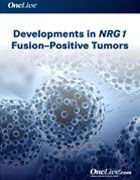Publication
Video
Special Issues
Dr. Duruisseaux on the Incidence of NRG1 Fusions in Solid Tumors
Author(s):
Michaël Duruisseaux, MD, a medical oncologist at Lyon Cancer Institute in France, discusses the incidence of NRG1 fusions in solid tumors.
Michaël Duruisseaux, MD, a medical oncologist at Lyon Cancer Institute, discusses the incidence of NRG1 fusions in solid tumors.
NRG1 is an actionable target that was first discovered in 2014, says Duruisseaux; it has been found in patients with EGFR-negative and KRAS-negative invasive mucinous adenocarcinoma. According to data presented at the 2019 ASCO Annual Meeting, the fusion has also been identified in select cases of nonmucinous lung adenocarcinoma and squamous lung carcinoma. The fusion can also be detected in up to half of all KRAS wild-type pancreatic cancers, as well as select cases of cholangiocarcinoma, ovarian cancer, and sarcoma, adds Duruisseaux.
The frequency of NRG1 fusions has not been well established but is thought to comprise less than 1% of these tumors overall. NRG1 fusions are believed to function as oncogenic drivers through activation of ErbB signaling pathways. As such, the irreversible pan-ErbB inhibitor, afatinib (Gilotrif) has shown deep and durable responses in patients with NRG1 fusion—positive lung cancer, KRAS wild-type pancreatic cancer, and cholangiocarcinoma, he concludes.










